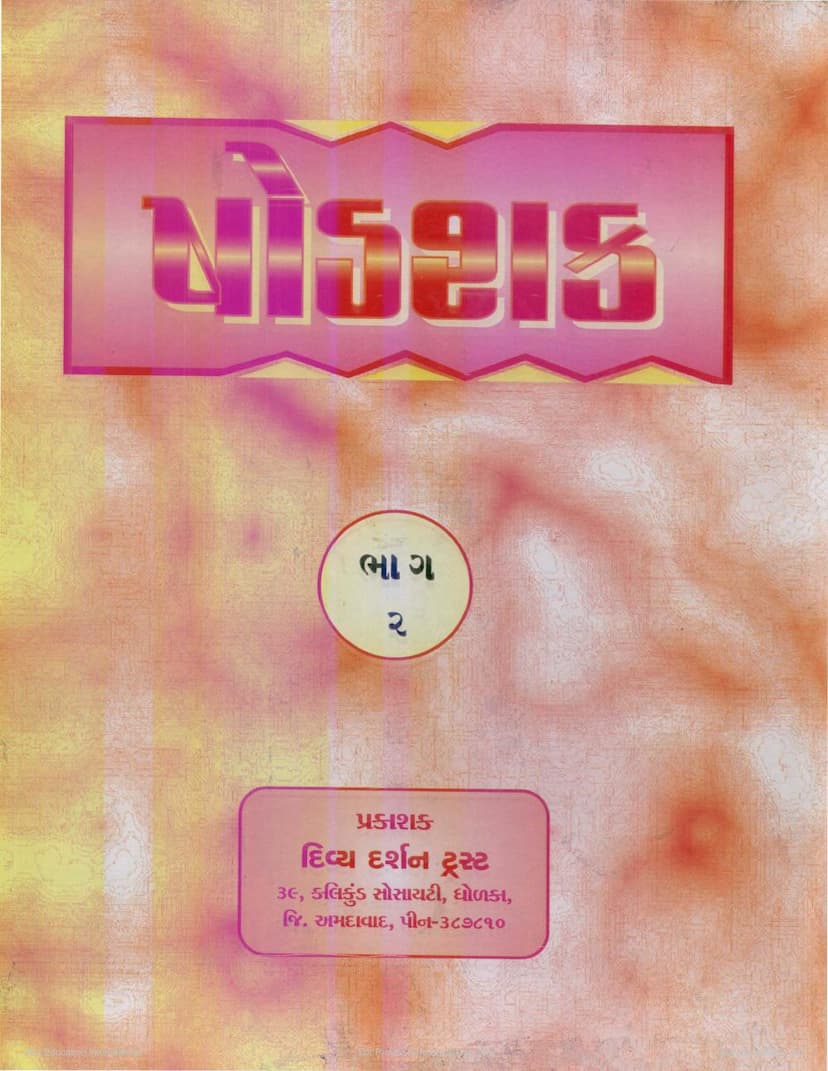Shokshaka Prakarana Part 2
Added to library: September 2, 2025

Summary
This is a comprehensive summary of the Jain text "Shokshaka Prakarana Part 2," based on the provided Gujarati text.
Book Title: Shokshaka Prakarana (षोडशक प्रकरण) - Part 2 Author(s): Acharya Shri Haribhadrasurishvarji (original text), Mahopadhyay Yashovijaygni (commentary), Muni Yashovijay (sub-commentary and Gujarati explanation) Publisher: Divya Darshan Trust Catalog Link: https://jainqq.org/explore/004834/1
Overall Summary:
"Shokshaka Prakarana Part 2" is the second volume of a commentary on the "Shokshaka Prakarana," an important Jain philosophical text originally authored by Acharya Shri Haribhadrasurishvarji. This specific volume features the Yogadipika commentary by Mahopadhyay Yashovijaygni and the Kalyan Kandali commentary with a Gujarati explanation by Muni Yashovijayji. It delves deeply into sixteen key philosophical and practical topics relevant to Jain spiritual practice and liberation.
The book is presented as a second edition, published by Divya Darshan Trust, with the blessings and inspirations of esteemed Jain Acharyas. It acknowledges the contributions of various scholars and patrons. The publication aims to make profound Jain teachings accessible to a wider audience, enabling spiritual progress on the path to liberation.
Key Themes and Content Discussed (Based on Page 3-11, the table of contents):
The table of contents indicates that this volume covers the following "Shodashaka" (sixteen topics), likely elaborating on various aspects of Jain practice and philosophy:
-
Ninth Shodashaka: Pooja (Worship)
- Detailed discussion on the nature and methods of divine worship.
- Consideration of different types of worship (Panchopachara, Ashtopachara, Sarvopachara).
- The importance of sincerity, proper procedure, and devotion in worship.
- Analysis of auspicious actions in worship, such as the use of specific flowers and fragrances.
- The philosophical underpinnings of worship and its role in spiritual progress.
-
Tenth Shodashaka: Sad-anushthan (Righteous Conduct/Action)
- The significance of virtuous actions and their impact on spiritual development.
- Discussion on the concept of "Punya" (merit) and its connection to good deeds.
- The role of "Kalyana" (well-being) and how righteous actions contribute to it.
- The principle of adhering to the correct path and the consequences of deviating from it.
- The importance of the "Kalyana-tri-padi" (auspicious triple-footed verses or principles).
-
Eleventh Shodashaka: Gyan (Knowledge)
- Exploration of different types of knowledge (Shruta Gyan, Chinta Gyan, Bhavana Gyan).
- The characteristics of right knowledge (Samyak Gyan) and its attainment.
- The necessity of proper conduct and reverence (Shushrusha) for acquiring true knowledge.
- The concept of knowledge that is free from faults and vices.
- The ultimate goal of knowledge: understanding the nature of reality and achieving liberation.
-
Twelfth Shodashaka: Diksha (Initiation/Asceticism)
- The eligibility and proper procedure for taking Diksha.
- The significance of Diksha as a means of atonement for past karmas.
- The qualities required for an ascetic and the importance of proper initiation.
- The concept of "Namasya" (names of deities) and its role in the ritual.
- The types of vows and conduct expected of ascetics.
-
Thirteenth Shodashaka: Sadhu-Sacheshta (Ascetic's Virtuous Conduct/Actions)
- The disciplined and righteous actions of an ascetic.
- The importance of Guru-vinaya (respect for the Guru) and its role in spiritual growth.
- The practice of Swadhyaya (self-study) and its significance for ascetics.
- The concept of Yoga-abhyasa (practice of Yoga) and its different forms.
- The principle of Pararth-karana (acting for the benefit of others) as a key aspect of ascetic life.
- The role of Maitri, Karuna, Mudita, and Upeksha (fourfold sentiments of loving-kindness, compassion, sympathetic joy, and equanimity) in spiritual development.
- The importance of controlling one's mind, senses, and actions.
-
Fourteenth Shodashaka: Yoga (Union/Meditation)
- Different types of Yoga, including Salambana (with an object of meditation) and Niravalambana (without an object).
- The philosophical discussion on the nature of Yoga, distinguishing it from mere physical postures.
- The role of the mind and its control in achieving Yoga.
- The concept of "Yoga-bhrashta" (one who falls from Yoga).
- The stages and practices of Yoga leading to spiritual realization.
-
Fifteenth Shodashaka: Dhyeya (Object of Meditation)
- The nature of the ultimate reality (Parama-tattva) that is the object of meditation.
- Description of the attributes of the Supreme Being, including formlessness, omnipresence, and transcending qualities.
- The path to achieving union with the Supreme Being through meditation.
- The concept of "Moksha" (liberation) as the ultimate goal and the role of meditation in achieving it.
-
Sixteenth Shodashaka: Samara (Equanimity/Harmony)
- The nature of spiritual equanimity and its importance in the spiritual path.
- The concept of "Samarasa" (equality or oneness) in spiritual realization.
- The transcendence of duality and the attainment of ultimate bliss.
- The union of the individual soul with the Supreme Being.
- The role of virtues like equanimity in achieving Moksha.
Commentaries and Explanations:
The text is enriched by the commentaries of Mahopadhyay Yashovijaygni (Yogadipika) and Muni Yashovijayji (Kalyan Kandali and Ratidayini Vyakhya). These commentaries aim to clarify the complex philosophical points of Haribhadrasurishvarji's original work, making it understandable for contemporary readers. The Gujarati explanation by Muni Yashovijayji is particularly noted for its accessibility.
Key Features Mentioned:
- Second Edition: The book is a second edition, indicating its popularity and importance.
- Divine Blessings: The publication is credited to the grace and inspiration of revered Acharyas.
- Scholarly Contributions: Several prominent Acharyas and scholars are mentioned as main researchers, highlighting the collaborative effort and intellectual depth behind the work.
- Purpose: The primary aim is to facilitate spiritual progress and the attainment of liberation.
- Knowledge as Offering: The book is published as "Jnana-dravya" (knowledge-substance), suggesting it is meant to be acquired through knowledge rather than mere commercial transaction.
Overall Impression:
The "Shokshaka Prakarana Part 2" is a significant work in Jain literature, offering a detailed exploration of crucial spiritual and philosophical concepts through the lens of classical commentaries. Its meticulous structure, covering sixteen distinct topics, and the insightful explanations provided by eminent scholars make it a valuable resource for Jain scholars and practitioners seeking a deeper understanding of their faith and path to liberation.